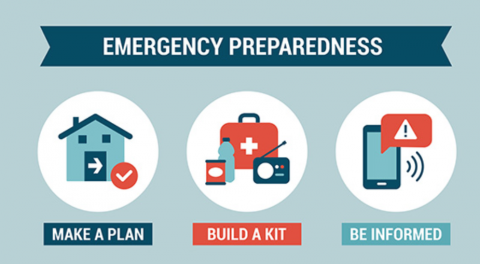Preparing for Disaster
It's important to develop a plan before a disaster strikes to keep you and your family safe. Here are some tips to help prepare before a disaster:
Click on the Checklist link to download a checklist helper for disaster preparation: Checklist
Safeguard Your Home
Know how to turn connections on/off. Know ahead of time how and when to safely turn off your electric, water, and propane in case you have to evacuate. Have the tools needed if it becomes necessary to do so.
Storm proof your home. Store plywood to cover windows during a hurricane. Check with your local code enforcement office about the appropriate thickness for your location.
Fasten your fuel tank to the ground or floor. If the fuel tank is not fastened, it could float if the area floods, causing pipes to break and spill fuel oil. Oil spills create health hazards and cleanup problems. Call your oil company if you are unsure if your tank is secure.
Document valuables. Keep a record of household possessions for insurance purposes. List model and serial numbers. Include photographs. Include expensive items and furniture too heavy to carry. Store the list in a safe-deposit box. Update it regularly.
Fill your bathtub with water if a heavy storm is predicted. The water can be disinfected in batches and used for drinking or cooking, or used as is for flushing toilets, washing, and other purposes.
Prepare Your Phone
Have electric-free phones. Have at least one mobile phone or corded, wall plug phone that works if the electricity goes out. Cordless phones won’t work when there is no power.
Charge mobile phones. Keep your mobile phone fully charged and have a portable charger. Portable chargers need either alkaline or watch batteries, or have a rechargeable battery. Know which type you have, stock up on the appropriate batteries, and keep your devices fully charged.
Maintain emergency contacts. Keep emergency phone numbers for your electric company, gas company, and water supplier near your phone, and save them into your cell phone.
Save emergency information so that you can access information quickly and easily on your cell phone and electronic devices.
Plan for Medical Needs
Check that you have a supply of your family’s prescription medications. Keep a current list of all medications, including dosages, schedules, and the prescribing doctor.
Prepare an emergency plan and kit for family members with mobility problems or special needs. The kit might include:
- Durable medical equipment
- Assistive technology
- Diabetic supplies
- Hearing aids and extra batteries
- A manual wheelchair
- Service animal supplies
Plan for Your Pets
During severe storms, consider crating pets for safety and comfort. You should also plan for their needs in case you have to evacuate. Have a designated person to care for pets or identify shelters that accept pets. Make sure shots are up to date. Never leave pets behind in a crate because they would be rendered helpless until you or someone else reaches them. Have these items for all pets:
- ID, collar, leash, 7 days worth of food and water, and food and water dishes
- Medications
- Crate and carrying cases for each pet
- Current photos and medical records
- Pet supplies for pet waste and bedding
- Garbage bags, hand sanitizer, paper towels for cleanup
Learn more at DHSES.
Buy a Battery-Powered Radio
Have a battery-powered radio for weather updates including official warnings, forecasts, and other hazard information. Make sure to have extra batteries. If you do not have a battery-powered radio, use your car radio. Depending on your car, it can be used for an hour or two without draining the car battery. Turn on the car engine outdoors only to recharge the battery. Never run your vehicle in an enclosed space or garage because it releases deadly carbon monoxide.
Get Timely Information
Save these links into your cell phone and other electronic devices so they are easy to locate when you need them.
- NY-Alert. Sign up to receive free warnings and emergency information via voice message, text message, or email. Or, download the free “iAlertz” app on your phone to receive alerts without signing up for an account.
- National Weather Service. Your local National Weather Service office provides up-to-date information about current weather, forecast maps, discussion, bulletins, and storm reports.
- NOAA Weather Radio. Get information on the NOAA Weather Radio All Hazards, a nationwide network broadcasting continuous weather information. You can also follow NOAA on their social media websites.
- Integrated Public Alert & Warning System. This national public Emergency Alert System (EAS) sends warnings via broadcast, cable, satellite, and wireless services to deliver important emergency information. It provides the President with the communications capability to address the American people within 10 minutes during a national emergency. EAS can be used when all other methods of alerting the public are unavailable.
